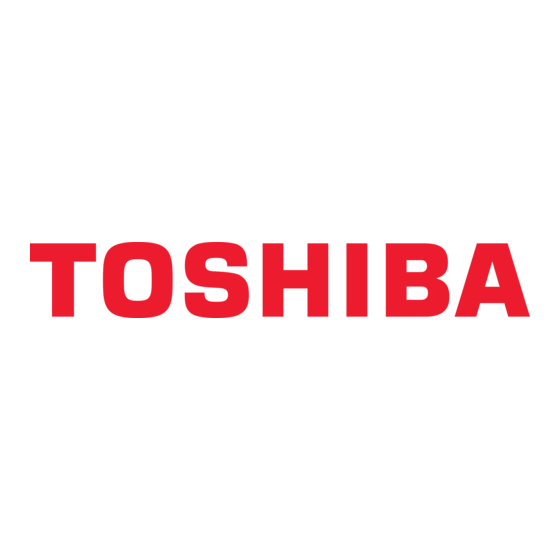
Table of Contents
Advertisement
Quick Links
Advertisement
Chapters
Table of Contents

Summarization of Contents
TOSHIBA Legal, Regulatory, and Safety
Copyright, Disclaimer and Trademarks
Details copyright, disclaimer, and trademark information for the manual.
Regulatory Information
Covers FCC, California Prop 65, and Export Administration regulations.
EU Declaration of Conformity
Explains CE compliance and working environment requirements.
Disposal of products
Instructions for proper disposal of the product and batteries.
Video Standard Notice
Licensing information for video standards like AVC, VC-1, and MPEG-4.
OpenSSL Toolkit License Issues
License terms for the OpenSSL toolkit used in the software.
FreeType License Issues
License terms for the FreeType Project font engine.
ENERGY STAR® Program
Information on the computer's ENERGY STAR compliance and energy efficiency.
Optical disc drive safety instructions
Safety precautions related to the laser system in the optical drive.
Location of the Required Label
Shows the location of the product's required label and manufacturing information.
General Precautions
General safety guidelines for using the computer.
Safety Icons
Explains the meaning of various safety icons used in the manual.
Getting Started
Equipment checklist
Lists hardware and documentation items to check after unpacking.
Conventions
Explains the manual's formatting for terms and operating procedures.
Using your computer for the first time
Basic information to start using the computer, including setup.
Turning on the power
Step-by-step instructions on how to power on the computer.
Getting to know Windows
Information on operating Windows, including the Start menu and taskbar.
Turning off the power
Procedures for shutting down, restarting, and managing power states.
Sleep Mode
Explanation of how to use and benefits of Sleep Mode.
Hibernation Mode
Details on how to use and benefits of Hibernation Mode.
System Recovery
Information on creating recovery media and restoring the system.
The Grand Tour
Front with the display closed
Identifies indicators and ports on the front of the computer when closed.
Left side
Identifies ports and slots on the left side of the computer.
Right side
Identifies ports and slots on the right side of the computer.
Back
Identifies components on the back of the computer, including the battery.
Underside
Identifies components on the underside of the computer, like battery locks and vents.
Front with the display open
Identifies components visible when the display is open.
Internal Hardware Components
Details key internal hardware components like CPU and storage.
Power Condition Descriptions
Explains the meaning of the DC IN/Battery and Power indicators.
Operating Basics
Using the Touch Pad
Explains how to use the Touch Pad and its various gestures.
The Keyboard
Overview of the keyboard layout, keys, and indicators.
Optical disc drive
Information on the optical drive, its formats, and usage.
CyberLink PowerDVD for TOSHIBA
Usage instructions and notes for the CyberLink PowerDVD software.
Using the AccuPoint
Instructions on how to use the AccuPoint pointing device.
Using the Fingerprint Sensor
Guide to enrolling and recognizing fingerprints for authentication.
Battery
Information on battery types, usage, charging, and care.
Utilities and Advanced Usage
Utilities and Applications
Overview of pre-installed utilities and how to start them.
Special features
Description of unique or advanced computer features.
TOSHIBA Password Utility
How to set and manage user and supervisor passwords.
TOSHIBA System Settings
How to configure hardware settings via TOSHIBA System Settings.
USB Charge
Information on charging external devices via USB ports.
Using the Hard Disk Drive (HDD) Protection
How to set up and use HDD Protection for disk safety.
TOSHIBA Setup Utility
How to access and use the BIOS setup utility.
Troubleshooting
Problem-solving process
Guidelines for diagnosing and resolving computer problems effectively.
Preliminary checklist
Basic checks for common issues before detailed troubleshooting.
Analyzing the problem
Questions to help identify the cause of computer malfunctions.
Common Issues and Solutions
Addresses issues like unresponsive programs, startup failures, and overheating.
Component-Specific Troubleshooting
Covers problems with AC power, battery, RTC, keyboard, display, storage, and optical drive.
Media and Input Device Issues
Troubleshooting for memory cards, touch pads, and mice.
Appendix
Specifications
Summarizes technical specifications including dimensions, environmental, and power requirements.
External RGB monitor port pin assignment
Details the pin assignments for the External RGB monitor port.
AC Power Cord and Connectors
Specifies requirements for AC power cords and connectors.
Information for Wireless Devices
Covers wireless technology interoperability, health considerations, and security.
Information about Intel® AMT
Provides information and instructions for disabling Intel Active Management Technology.
Information about Intel® Authenticate
Directs users to Intel's website for information on Intel Authenticate.
Legal Footnotes
Explains legal footnotes related to CPU performance and other topics.
Glossary
Defines terms and abbreviations used throughout the manual.













Need help?
Do you have a question about the TECRA Z50-D and is the answer not in the manual?
Questions and answers